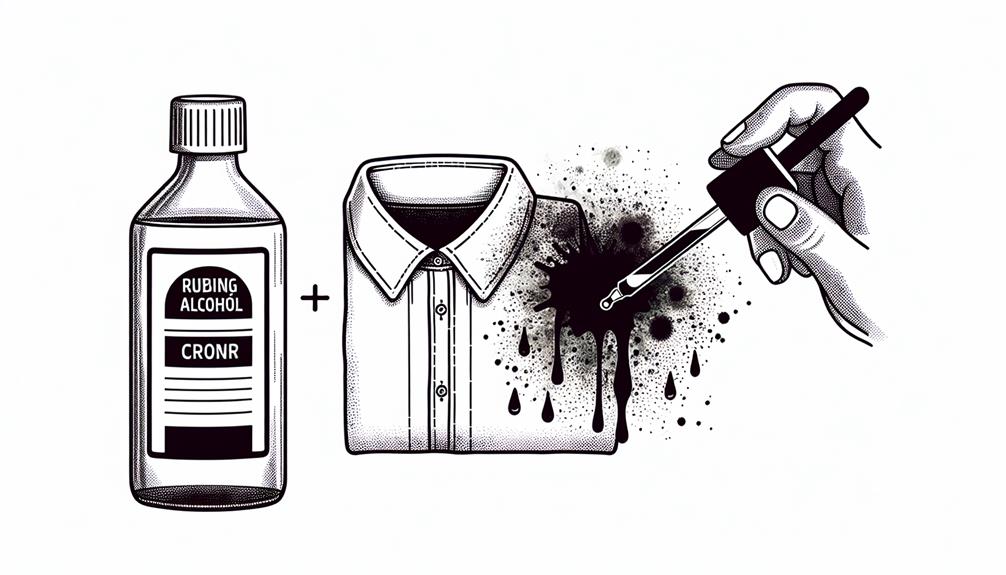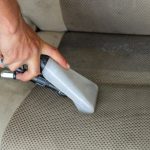Like a secret weapon in the battle against stubborn stains, rubbing alcohol has long been hailed for its stain-removing capabilities. But does it truly live up to the hype?
Let's explore the effectiveness of this household staple when it comes to tackling various types of stains. From ink marks to coffee spills, the versatility of rubbing alcohol might surprise you.
So, before you reach for that traditional stain remover, consider the potential power of this underrated solution.
Table of Contents
Key Takeaways
- Rubbing alcohol effectively removes tough stains like ink, grease, and adhesive residue.
- It penetrates fabric and solubilizes stains, making it versatile for different types of stains.
- Application techniques like blotting and pre-soaking enhance its stain removal effectiveness.
- Understanding its strengths, limitations, and precautions ensures successful stain removal outcomes.
Types of Stains Rubbing Alcohol Can Remove
When tackling stains, rubbing alcohol proves effective on a variety of surfaces and fabrics due to its powerful solvent properties. Alcohol solutions are particularly adept at breaking down and lifting stains from surfaces, making them a versatile tool for stain removal.
One common type of stain that rubbing alcohol can successfully tackle is ink stains. Whether it's from a leaky pen or a printing mishap, rubbing alcohol can often dissolve the ink, allowing for easier removal. Additionally, alcohol solutions can be effective in removing grease and oil stains from fabrics and hard surfaces. These stains can be notoriously stubborn, but rubbing alcohol's ability to break down oils makes it a valuable ally in the fight against greasy marks.
Moreover, rubbing alcohol can also be beneficial in removing adhesive residue from stickers or labels. Its solvent properties help weaken the adhesive, making it easier to peel off without leaving a sticky mess behind. Overall, the versatility and effectiveness of rubbing alcohol in stain removal make it a must-have in any cleaning arsenal.
Benefits of Using Rubbing Alcohol
One of the key benefits of using rubbing alcohol is its versatility in tackling a wide range of stains on various surfaces and fabrics. Rubbing alcohol offers several advantages when it comes to stain removal.
- Effectiveness: Rubbing alcohol is highly effective in removing tough stains such as ink, grease, and makeup. Its solvent properties help break down the stains, making them easier to lift off surfaces.
- Quick Drying: Unlike water-based stain removal methods, rubbing alcohol evaporates quickly, which can help prevent the spread of the stain and reduce the overall drying time of the treated area.
- Non-Staining: Rubbing alcohol is less likely to leave behind residue or cause discoloration on fabrics and surfaces, making it a reliable choice for treating stains without causing additional damage.
How Rubbing Alcohol Works on Stains
When it comes to understanding how rubbing alcohol works on stains, it's important to contemplate the stain penetration mechanism, how alcohol solubilizes the stain, and the various application methods for different types of stains.
This three-pronged approach helps address the core principles behind rubbing alcohol's stain-removing capabilities, making it easier to tackle stubborn marks effectively.
Stain Penetration Mechanism
With a penetrating action, rubbing alcohol effectively breaks down and removes stains on various surfaces. When dealing with stains, understanding how rubbing alcohol works can be important for successful removal.
Here's why rubbing alcohol is a stain-fighting powerhouse:
- Penetrating Power: Rubbing alcohol seeps into the fabric, attacking the stain at its core.
- Breaks Down Stains: It dissolves the components of the stain, making it easier to lift off the surface.
- Versatile Usage: From fabrics to hard surfaces, rubbing alcohol proves to be a versatile stain remover.
Mastering the stain penetration mechanism of rubbing alcohol can elevate your fabric care routine and help you tackle stubborn stains effectively.
Alcohol Solubilizes Stain
Solubilizing stains, rubbing alcohol effectively breaks down and removes them from various surfaces with its penetrating action. Its efficiency in removing stains lies in its chemical composition, primarily composed of isopropyl alcohol, which acts as a solvent to dissolve the stain particles.
This solubilization process helps break the bond between the stain and the surface, making it easier to wipe away. Rubbing alcohol's ability to dissolve a wide range of substances makes it versatile for tackling different types of stains, such as ink, grease, or even certain types of dyes.
Understanding how rubbing alcohol interacts with stains can enhance your stain removal techniques, ensuring a cleaner and more pristine surface.
Application Methods for Stains
To effectively apply rubbing alcohol on stains, consider using targeted techniques that maximize its solubilizing properties for best removal results. When dealing with stubborn stains, the application method can make a significant difference in the outcome.
Here are some stain removal techniques and cleaning solutions to help you tackle those pesky marks:
- Blotting Technique: Gently blot the stain with a cloth soaked in rubbing alcohol, being careful not to rub vigorously.
- Spray and Dab Method: Spray rubbing alcohol directly on the stain and dab it with a clean cloth to lift the mark effectively.
- Pre-Soaking Approach: Soak the stained fabric in rubbing alcohol before washing to loosen the stain for easier removal.
These methods can enhance the effectiveness of rubbing alcohol in removing various types of stains.
Precautions When Using Rubbing Alcohol
When using rubbing alcohol, always make sure to work in a well-ventilated area to prevent inhaling fumes.
It's important to steer clear of open flames as rubbing alcohol is highly flammable.
Prioritize safety by following these precautions when using rubbing alcohol for stain removal.
Proper Ventilation During Use
Ensuring proper ventilation while using rubbing alcohol is essential to prevent inhalation of fumes that can be harmful to your health. When working with rubbing alcohol, follow these ventilation safety tips:
- Ventilation Safety: Place a fan near an open window to circulate fresh air and push fumes outside.
- Proper Technique: Work in a well-ventilated area to minimize exposure to the strong odor of rubbing alcohol.
- Protective Measures: Consider wearing a mask or using a respirator to further reduce the risk of inhaling harmful vapors.
Avoid Open Flames
Properly using rubbing alcohol involves being cautious around open flames to prevent potential hazards. When working with rubbing alcohol, fire safety is paramount. Avoid using it near open flames, as rubbing alcohol is highly flammable. Even a small spark can ignite the fumes, leading to a dangerous situation.
Always extinguish any nearby flames before using rubbing alcohol and guarantee proper ventilation to reduce the concentration of fumes in the air. Ventilation concerns are essential to prevent the buildup of flammable vapors. Be mindful of your surroundings and take the necessary precautions to keep yourself and your environment safe.
Steps to Remove Stains With Rubbing Alcohol
To effectively remove stains with rubbing alcohol, start by identifying the type of stain and the fabric it's on. When dealing with stains, follow these simple steps:
- Assess the Stain: Determine the nature of the stain (e.g., grease, ink, or food stains) and the fabric type to choose the best approach.
- Prep the Area: Blot the excess stain gently with a clean cloth to prevent it from spreading further.
- Apply Rubbing Alcohol: Using a clean cloth soaked in rubbing alcohol, dab the stained area gently. Avoid rubbing vigorously, as this may damage the fabric.
Next, consider the stain removal techniques and cleaning solutions suitable for the specific stain and fabric. Remember, different stains may require different approaches, so always test a small, inconspicuous area first. By following these steps diligently, you can effectively tackle stains with rubbing alcohol, restoring your fabrics to their pristine condition.
Testimonials: Rubbing Alcohol Success Stories
I've heard some amazing rubbing alcohol success stories that truly showcase its stain-removing power. Users have shared their experiences where rubbing alcohol saved their favorite clothes or carpets from stubborn stains. One user mentioned how a mixture of rubbing alcohol and water effortlessly removed a red wine stain from their white shirt, leaving no trace behind. Another user praised rubbing alcohol for eliminating ink stains from their child's artwork on the sofa, restoring it to its former glory. These success stories highlight the versatility and effectiveness of rubbing alcohol in tackling various types of stains.
| Success Stories | User Experiences | Impact |
|---|---|---|
| Red wine stain removal | White shirt restored | Excellent |
| Ink stain elimination | Sofa saved from artwork stains | Impressive |
| Grease stain disappearance | Kitchen counter spotless | Remarkable |
These testimonials not only demonstrate the potential of rubbing alcohol but also provide hope for those struggling with tough stains. It's inspiring to see how a simple household item can make such a significant difference.
Common Misconceptions About Rubbing Alcohol
Common misconceptions about rubbing alcohol often lead to misunderstandings about its true capabilities in stain removal. It's important to debunk these myths to fully understand the potential of this versatile cleaning solution.
- Rubbing alcohol can only remove certain types of stains.
- Using rubbing alcohol in excessive amounts will guarantee better results.
- Rubbing alcohol is a pivotal solution for all types of cleaning needs.
As someone who values mastery in cleaning solutions, it's pivotal to recognize the real strengths and limitations of rubbing alcohol. While it's indeed effective for certain stains, such as ink or marker, it may not work as effectively on others like grease or food stains. Additionally, using rubbing alcohol in moderation is key, as excessive amounts can actually damage certain materials. Understanding these misconceptions will help you make informed decisions when using rubbing alcohol for stain removal, ensuring successful outcomes every time.
Conclusion: Rubbing Alcohol as a Stain Remover
After dispelling common misconceptions about rubbing alcohol's stain removal capabilities, it becomes evident that understanding its strengths and limitations is necessary for successful cleaning outcomes. Rubbing alcohol can effectively remove certain stains like ink, grease, or adhesive residue due to its solvent properties. However, it may not be as effective for other types of stains such as food or grass stains. In such cases, alternative methods like vinegar, baking soda, or commercial stain removers might be more suitable.
When considering rubbing alcohol as a stain remover, its effectiveness varies based on the type of stain and fabric. It's essential to test it on a small, inconspicuous area first to make sure it doesn't damage the material. Additionally, while rubbing alcohol can be useful for spot cleaning, it may not always provide a thorough solution for tough stains.
Moreover, it's vital to ponder the environmental impact and sustainability of using rubbing alcohol. Opting for eco-friendly alternatives whenever possible can minimize chemical exposure and reduce harm to the environment. Overall, understanding the strengths and limitations of rubbing alcohol as a stain remover is key to achieving successful cleaning results.
Frequently Asked Questions
Can Rubbing Alcohol Be Used on All Types of Fabrics and Materials?
When considering fabric compatibility, rubbing alcohol can be used on many types, but always test on a hidden area first. It's great for stain removal on various materials, but caution is key to avoid potential damage.
Are There Any Specific Types of Stains That Rubbing Alcohol May Not Be Effective Against?
Certain tough stains like ink or oil may not respond well to rubbing alcohol. I've discovered that for stubborn marks, alternative methods like enzyme cleaners or specialized stain removers can be more effective due to alcohol's limitations.
Does the Concentration of Rubbing Alcohol Affect Its Effectiveness in Removing Stains?
Higher alcohol concentration can increase efficacy in stain removal, but may impact fabric compatibility. Testing on a small, inconspicuous area is wise. Consider effectiveness and potential fabric damage when choosing the best concentration for stain removal.
Can Rubbing Alcohol Cause Damage or Discoloration to Certain Surfaces?
When considering rubbing alcohol for cleaning, it's crucial to pay attention to surface compatibility to avoid potential damage. There is a risk of discoloration with improper application, so always test on a small area first.
Is There a Recommended Method for Storing Rubbing Alcohol to Maintain Its Effectiveness as a Stain Remover?
For proper storage of rubbing alcohol to maintain effectiveness as a stain remover, it's key to keep it in a cool, dark place and tightly sealed. Shelf life can vary but following application techniques promptly guarantees best results.
- A Shopper’s Map: Finding Genuine Chanderi Sarees in Indore - June 25, 2025
- Your Shopping Guide: Where to Buy the Best Chanderi Sarees in Bhopal - June 25, 2025
- Where to Buy Authentic Chanderi Silk Fabric and Sarees Online - June 25, 2025






